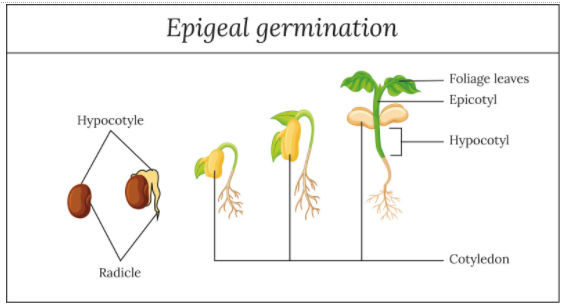
Germination is epigeal in -
(a)Zea mays
(b)Helianthus
(c)Mangifera
(d)Pisum
Answer
488.4k+ views
Hint: The term ‘epi’ means below something. And since we are understanding about germination, there are plants that may germinate above or below the ground surface. Germination can occur above or below ground depending on the type of the plant seed.
Complete answer:
- Epigeal germination is the type where the cotyledons are above the soil surface as the hypocotyl elongates very rapidly. The epicotyl remains unchanged in length.
- Examples of epigeal germination are cotton, sunflower, castor, and bean (or common bean).
- As epigeal germination plants are more vulnerable to grazing and weather conditions, the plants produce a large number of seeds as an evolutionary strategy.
Additional Information: - Hypogeal germination is the type where the cotyledons stay below the ground, the epicotyl above the cotyledon grows, while the hypocotyl below the cotyledon remains the same in length.
- Examples of hypogeal germination include pea, mango, maize, and lily.
- Here, the plumule pushes the cotyledons out of the soil.
- The cotyledons are fleshy and as they stay below ground, they develop a survival strategy that they are resistant to cold temperatures or grazing.
- Hypogeal germination also occurs in plants where low nutrient soils and low sunlight conditions are favored. They are also resistant to flooding.
- Plants with hypogeal germination grow relatively slower while those with epigeal germination grow faster. This is also dependent on their resistance to flooding. Since epigeal plants are not resistant to flooding, rapid growth allows them to develop before the area is flooded again.

So, the correct answer is ‘Helianthus’.
Note: - Two species in the same genus can show different types of germination. For example, the runner bean or the Phaseolus coccineus shows hypogeal germination while the common bean Phaseolus vulgaris shows epigeal germination.
Complete answer:
- Epigeal germination is the type where the cotyledons are above the soil surface as the hypocotyl elongates very rapidly. The epicotyl remains unchanged in length.
- Examples of epigeal germination are cotton, sunflower, castor, and bean (or common bean).
- As epigeal germination plants are more vulnerable to grazing and weather conditions, the plants produce a large number of seeds as an evolutionary strategy.
Additional Information: - Hypogeal germination is the type where the cotyledons stay below the ground, the epicotyl above the cotyledon grows, while the hypocotyl below the cotyledon remains the same in length.
- Examples of hypogeal germination include pea, mango, maize, and lily.
- Here, the plumule pushes the cotyledons out of the soil.
- The cotyledons are fleshy and as they stay below ground, they develop a survival strategy that they are resistant to cold temperatures or grazing.
- Hypogeal germination also occurs in plants where low nutrient soils and low sunlight conditions are favored. They are also resistant to flooding.
- Plants with hypogeal germination grow relatively slower while those with epigeal germination grow faster. This is also dependent on their resistance to flooding. Since epigeal plants are not resistant to flooding, rapid growth allows them to develop before the area is flooded again.

So, the correct answer is ‘Helianthus’.
Note: - Two species in the same genus can show different types of germination. For example, the runner bean or the Phaseolus coccineus shows hypogeal germination while the common bean Phaseolus vulgaris shows epigeal germination.
Recently Updated Pages
Master Class 9 General Knowledge: Engaging Questions & Answers for Success

Master Class 9 English: Engaging Questions & Answers for Success

Master Class 9 Science: Engaging Questions & Answers for Success

Master Class 9 Social Science: Engaging Questions & Answers for Success

Master Class 9 Maths: Engaging Questions & Answers for Success

Class 9 Question and Answer - Your Ultimate Solutions Guide

Trending doubts
State and prove Bernoullis theorem class 11 physics CBSE

Who built the Grand Trunk Road AChandragupta Maurya class 11 social science CBSE

1 ton equals to A 100 kg B 1000 kg C 10 kg D 10000 class 11 physics CBSE

State the laws of reflection of light

One Metric ton is equal to kg A 10000 B 1000 C 100 class 11 physics CBSE

Difference Between Prokaryotic Cells and Eukaryotic Cells




